In the current economic climate, the necessity of a substantial financial safety net cannot be overstated. A recent financial analysis revealed a significant shortfall in savings cushion among many individuals, highlighting the critical need for financial preparedness.
An emergency fund acts as a critical safeguard against unforeseen financial disruptions, ensuring both peace of mind and financial stability. The question persists, though, as to whether exceeding the conventional six-month savings threshold is imperative. This exploration delves into the established benchmarks for emergency savings, alongside the variables that dictate the optimal reserve, aiming to empower you with the knowledge to fortify your financial security.
Key Takeaways
- Understanding the importance of having an adequate emergency fund.
- General guidelines for determining the ideal emergency fund size.
- Factors that influence the amount you should save.
- The role of financial preparedness in overall financial health.
- Strategies for building and maintaining your emergency savings.
Understanding the Purpose of an Emergency Fund
An emergency fund serves as a critical buffer against unforeseen financial disruptions, such as job loss or sudden medical emergencies. It constitutes a reserve of funds, strategically set aside to absorb unexpected expenses, preventing the erosion of long-term savings or the accumulation of debt.
A recent survey conducted by a leading financial institution revealed a stark reality: a substantial proportion of households are woefully underprepared for emergencies. This statistic underlines the imperative of comprehending the emergency fund’s role in safeguarding financial stability. By establishing such a fund, individuals can circumvent the financial strain that accompanies unforeseen events.
The advantages of an emergency fund are far-reaching. It functions as a financial safety net, enabling the coverage of vital expenses during unemployment or when confronted with unforeseen bills, such as car repairs or medical emergencies. It also empowers individuals to make decisions without being constrained by financial pressures.
Posessing a substantial emergency fund can be transformative during times of crisis. It allows you to:
- Cover unexpected expenses without resorting to debt
- Preserve your standard of living during unemployment
- Prevent the depletion of retirement savings
- Make financial decisions without undue pressure
In essence, an emergency fund transcends its status as a mere savings account; it is a financial lifeline that instills peace of mind and security. By grasping its purpose and benefits, one can fully appreciate the significance of cultivating and preserving such a fund.
How Much Should You Save in an Emergency Fund?
Financial experts often advocate for saving three to six months’ worth of expenses, yet this recommendation is not universally applicable. The optimal size for an emergency fund can significantly vary based on individual circumstances.
Several factors influence the appropriate amount to save in your savings cushion. Grasping these factors is essential for determining your financial preparedness and financial security.
Factors Influencing Emergency Fund Size
The size of your emergency fund should be influenced by your income stability, job security, and other financial obligations. For instance, if you have a stable job with a steady income, you might require a smaller emergency fund compared to someone with a variable income.
- Income stability and job security
- Number of dependents
- Other financial obligations, such as debt
- Health and insurance status
Let’s consider how different factors can affect the size of your emergency fund through the following table:
| Factor | Consideration | Impact on Emergency Fund |
|---|---|---|
| Income Stability | Stable income | Lower savings needed |
| Job Security | High job security | Lower savings needed |
| Dependents | More dependents | Higher savings needed |
| Debt | High debt levels | Higher savings needed |
In conclusion, while the general guideline is to save three to six months’ worth of expenses, the right amount for you will depend on your unique financial situation. Assessing your personal factors and adjusting your savings according to these is key to achieving financial security.
Assessing Your Financial Situation
To construct a formidable financial safety net, it is imperative to grasp your current fiscal standing. This comprehension enables the determination of an appropriate emergency fund size, ensuring readiness for unforeseen expenses.
An examination of your financial health necessitates scrutiny of several critical elements, including your income, expenditures, debts, and other fiscal commitments. Initiate by computing your monthly earnings and documenting your expenses to discern the allocation of your financial resources. This exercise facilitates the identification of opportunities for expense reduction, allowing for increased contributions to your emergency savings.
Subsequently, consider your debt load, encompassing credit card balances, loans, and mortgages. High-interest debts exert a considerable influence on your fiscal stability, necessitating their inclusion in your emergency fund calculations. Further contemplation should be given to other fiscal responsibilities, such as utility bills, insurance premiums, and regular savings contributions.
A recent investigation underscored the significance of financial situation assessment in determining an adequate emergency fund size. The study revealed that individuals who frequently evaluate their financial health are more adept at navigating financial crises. This finding emphasizes the necessity of a detailed financial assessment to achieve financial stability and security.
To streamline the assessment process, consider the following steps:
- Calculate your monthly income and fixed expenses.
- Identify areas where you can reduce spending.
- Evaluate your debts and other financial obligations.
- Determine your emergency fund needs based on your financial situation.
By adhering to these steps, you can establish a customized emergency fund that resonates with your financial circumstances, bolstering your overall financial preparedness.
Benefits of Having More Than 6 Months’ Expenses
Exceeding the conventional six-month savings threshold can profoundly elevate one’s financial tranquility and stability. Such an accumulation, as underscored by ET Markets, fortifies financial security during protracted economic recessions. It serves as a critical buffer during periods of heightened uncertainty.
The primary advantage of a more substantial emergency fund lies in its capacity to instill financial stability. It empowers individuals to navigate through unforeseen financial challenges, such as unemployment or unforeseen medical bills, without succumbing to debt.
The advantages of maintaining an emergency fund exceeding six months’ expenses are diverse. It encompasses:
- Enhanced financial security
- Peace of mind during economic uncertainty
- Flexibility to seize new opportunities
- Protection against financial shocks
To demonstrate the significance of a larger emergency fund, consider the following comparison:
| Emergency Fund Size | Financial Security Level | Peace of Mind |
|---|---|---|
| Less than 3 months | Low | Limited |
| 3-6 months | Moderate | Moderate |
| More than 6 months | High | Significant |
In summary, surpassing the six-month savings benchmark can markedly improve one’s financial security and stability. It establishes a robust savings cushion against the unpredictabilities of life.
Drawbacks of an Overly Large Emergency Fund
The establishment of a substantial emergency fund is indispensable for financial security. Yet, an excessively large fund can precipitate financial inefficiencies. This scenario necessitates a reevaluation of one’s financial strategy.
One of the primary concerns with an overly large emergency fund is the opportunity cost. The retention of substantial sums in low-yield savings accounts precludes the possibility of achieving higher returns from alternative investments. As Mirae Asset’s Fund Manager astutely observed, “Keeping too much money in a low-yield savings account can result in opportunity costs and inflation risks.”
The opportunity costs can be substantial. For example, if you have $100,000 in a savings account earning 1% interest, you are forgoing potentially higher returns from investments such as stocks or bonds. Several considerations are pertinent:
- Liquid savings accounts typically offer lower interest rates compared to other investment options.
- Inflation can erode the purchasing power of your savings over time.
- Diversifying your savings across different asset classes can help mitigate some of these risks.
Conversely, an overly large emergency fund can induce complacency in financial planning. Achieving a balance between emergency preparedness and long-term financial objectives is imperative. It is essential to maintain financial preparedness without neglecting other facets of one’s financial health.
In conclusion, while a savings cushion is vital for financial security, it is critical to be cognizant of the downsides of an excessively large fund in a low-yield account. By comprehending these drawbacks, one can make more informed decisions regarding their emergency fund and overall financial strategy.
How to Calculate Your Ideal Emergency Fund
To ensure you’re prepared for unexpected expenses, it’s vital to calculate your ideal emergency fund. This involves assessing your monthly expenses, income, and other financial obligations.
Step 1: Determine Your Monthly Essential Expenses
Start by calculating your average monthly essential expenses, including rent/mortgage, utilities, groceries, transportation, and minimum payments on debts.
For example, if your monthly essential expenses are $3,000, this will be your base figure.
Step 2: Consider Your Income Stability
If you have a stable job with a regular income, you might need less in your emergency fund compared to someone with a variable income or who is self-employed.
Step 3: Account for Other Financial Obligations
Consider any other financial obligations you have, such as debt repayment, savings goals, and other regular expenses.
| Financial Stability | Ideal Emergency Fund Size |
|---|---|
| Stable Income | 3-6 months of expenses |
| Variable Income | 6-9 months of expenses |
| High-Risk Job or Self-Employed | 9-12 months of expenses |
By following these steps and considering your individual circumstances, you can determine the ideal size for your emergency fund, ensuring you’re prepared for financial shocks.
Where to Keep Your Emergency Fund
The selection of an appropriate repository for your emergency fund is imperative for the maintenance of financial equilibrium. It necessitates a balance between accessibility and the avoidance of frivolous expenditures. This dichotomy is critical in safeguarding your financial well-being.
Opting for a high-yield savings account emerges as a preferred choice. Such accounts boast superior interest rates relative to conventional savings vehicles, facilitating the incremental growth of your emergency reserve. This growth is concurrent with the preservation of liquidity, ensuring that your funds remain readily accessible when needed.
An alternative consideration is a money market fund. These funds invest in low-risk, short-term debt instruments, potentially yielding competitive returns. It is, though, imperative to select a fund that maintains liquidity and exhibits a minimal expense ratio, to maximize returns without compromising accessibility.
A comparative analysis of various savings account options for emergency funds is presented below:
| Account Type | Interest Rate | Liquidity | Risk Level |
|---|---|---|---|
| High-Yield Savings Account | 2.0% – 2.5% | High | Low |
| Money Market Fund | 1.5% – 3.0% | High | Low to Moderate |
| Traditional Savings Account | 0.1% – 0.5% | High | Low |
In deliberating upon the optimal location for your emergency fund, it is essential to weigh factors such as interest rates, liquidity, and risk levels. A critical consideration is the segregation of your emergency fund from your everyday spending monies, to preclude the propensity for non-essential disbursements.
The quintessential repository for your emergency fund is one that harmonizes accessibility with the prospect for growth, ensuring preparedness for unforeseen expenses while upholding your financial stability.
Using Your Emergency Fund Wisely
The true value of an emergency fund is not merely in its accumulation but in its strategic deployment during financial exigencies. It transcends the mere accumulation of capital; it necessitates a profound understanding of its deployment efficacy.
As elucidated by Mirae Asset’s Fund Manager, “An emergency fund serves as a financial airbag; it is indispensable for traversing through unforeseen expenses and economic downturns.” Wise usage entails reserving this fund for authentic emergencies, such as unforeseen medical expenditures, vehicular repairs, or employment loss.
- Assess the urgency of the expense: Is it immediate, or can it wait?
- Evaluate the impact of not addressing the expense: Will it lead to more significant financial problems?
- Consider alternative solutions: Can you borrow from a low-interest source or find another way to address the need?
Experts in financial preparedness advocate for the maintenance of a readily accessible savings account for emergencies, which can substantially alleviate financial stress. “It’s about being prepared for the unexpected,” an expert posits. “By possessing a financial cushion, you circumvent the necessity of precipitous financial decisions during crises.”
“The key to financial security isn’t just saving; it’s about being smart about when you use your savings.”
By judiciously utilizing your emergency fund, you uphold financial security and ensure readiness for future unforeseen expenses. This methodology aids in circumventing debt and preserving stability amidst economic downturns.
Staying Motivated to Save

The pursuit of financial preparedness necessitates unwavering motivation to save. A substantial emergency fund serves as a critical savings cushion, bolstering financial security significantly.
Financial experts advocate for the establishment of clear, attainable objectives. For example, setting a monthly savings target can simplify the process. The practice of automating savings, through automatic transfers from your checking to your savings or emergency fund, ensures consistent contributions.
Regularly revisiting and refining your budget is essential to align with your savings objectives. Visualizing your advancement towards these goals can serve as a potent motivator. For further guidance on managing your finances, exploring resources on how to start investing with minimal capital may be beneficial.
| Motivation Strategy | Description | Benefit |
|---|---|---|
| Set Clear Goals | Define specific savings targets | Increased focus |
| Automate Savings | Use automatic transfers | Consistency |
| Regular Reviews | Adjust budget as needed | Improved financial health |
Adopting these strategies enables individuals to sustain their commitment to saving. This, in turn, enhances their financial security and readiness for unforeseen expenses.
Alternatives to an Emergency Fund
Not all individuals require or desire a substantial emergency fund; alternative financial safety nets may serve as a more suitable option. The necessity of a financial cushion for financial security is undeniable, yet certain financial tools might better align with one’s specific needs or circumstances.
A line of credit emerges as a viable alternative to a traditional emergency fund. It enables borrowing up to a predetermined limit, with interest only accruing on the borrowed amount. This method is advantageous for addressing unforeseen expenses without the obligation of maintaining a substantial savings account.
Another strategy involves leveraging low-interest credit cards for emergency expenditures. Though prudent credit card management is imperative, a card with a low interest rate can function as a financial safety net. It is, though, critical to settle the balance expeditiously to circumvent the accrual of high-interest charges.
Some financial advisors advocate for a robust investment portfolio as an emergency funding mechanism. Though investments are inherently volatile, a diversified portfolio might offer the necessary liquidity during financial crises. This strategy necessitates meticulous planning and a thorough comprehension of the associated risks.
Further, certain insurance products can function as a financial safety net. For example, disability insurance can replace income in the event of incapacitation, while health insurance can mitigate medical expenses. These insurance solutions are integral to a holistic financial strategy.
Lastly, the role of family and friends as a financial safety net should not be overlooked. In some instances, a support network capable of providing financial aid during emergencies can be invaluable. It is, though, imperative to establish clear expectations and understanding within such arrangements.
In summary, while a traditional emergency savings fund remains a fundamental aspect of financial planning, alternative strategies can complement or replace it. By exploring these options, individuals can develop a more personalized approach to achieving financial security.
Making Adjustments Over Time
The determination of your emergency fund’s size is not a static decision; it necessitates periodic reassessment. As your financial circumstances evolve, so must your emergency fund. Regular evaluations are imperative to guarantee your fund’s congruence with your current fiscal requirements.
Varied elements can sway the magnitude of your emergency fund, encompassing shifts in income, expenses, employment stability, and financial commitments. For example, transitioning to a more stable employment or eliminating substantial debt might prompt adjustments to your fund. On the other hand, escalating expenses or diminished income could necessitate an increase in your emergency fund.
To adeptly modify your emergency fund over time, consider the following steps:
- Regularly review your budget and financial objectives.
- Assess any changes in your job security or income stability.
- Adjust your fund based on changes in expenses or financial obligations.
- Consider the impact of major life events, such as marriage, having children, or retirement.
Financial experts, including those at Mirae Asset, underscore the importance of periodic adjustments to your emergency fund for maintaining financial preparedness. By remaining proactive and making necessary adjustments to your emergency fund, you can ensure it remains a dependable safety net during unforeseen circumstances.
Expert Opinions on Emergency Savings

Financial planners concur that an emergency fund is a cornerstone of a robust financial strategy. Experts posit that a reserve of savings can markedly diminish financial anxiety and foster tranquility.
Financial advisors underscore that the magnitude of the emergency fund is contingent upon personal factors, including employment stability, income predictability, and familial obligations. For example, ET Markets advocates for a reserve exceeding six months’ living expenses for those with unpredictable income or precarious employment.
“An emergency fund is not just a safety net; it’s a financial lifeline that can help you navigate unexpected expenses or income disruptions without going into debt.”
Experts further stress the necessity of housing the emergency fund in a liquid savings account, such as a high-yield savings account, to balance accessibility with interest earnings.
As Hudson Valley One highlights, another vital consideration is the periodic reassessment and adjustment of the emergency fund to reflect evolving financial scenarios. This might necessitate augmenting the fund during periods of heightened expenditure or when anticipating financial vulnerabilities.
Essential tactics for adept emergency fund management include:
- Consistent contributions to the fund
- Segregation of the fund from daily expenditures
- Periodic reassessment and adjustment of the fund’s size
Adhering to these expert recommendations and best practices enables individuals to bolster their financial preparedness and attain enhanced financial security through a diligently managed emergency savings strategy.
Conclusion: The Right Amount for You
Establishing the precise magnitude of your emergency fund is imperative for attaining financial preparedness and security. The consensus is that exceeding six months’ worth of expenses in savings can act as a buffer against unforeseen expenses and financial disruptions, fostering financial stability.
Experts, such as those at Mirae Asset, underscore the significance of evaluating individual circumstances to ascertain the most suitable emergency fund size. Considerations must include job stability, income consistency, and familial responsibilities when determining the appropriate savings amount.
The cornerstone of financial security lies in possessing an emergency fund that resonates with your financial standing and objectives. By comprehending your specific needs and maintaining a readily accessible savings account, you can ensure readiness for life’s unpredictabilities and progress towards enduring financial stability.






